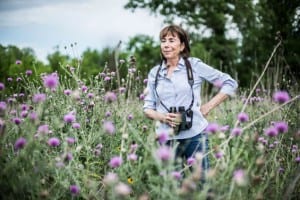The history of the entire Trinity River bottoms is mainly a matter of conjecture and guesswork.
The Dallas Observer has covered the research of SMU paleobotanist Bonnie Jacobs, a professor in SMU’s Roy M. Huffington Department of Earth Sciences. Jacobs is working with a team of SMU students and faculty who are collaborating with others in Dallas to understand the history of the area’s Trinity River. The Observer article published June 26 as part of the Observer’s profile of 20 of the metro area’s most interesting characters in its Dallas Observer People Issue.
Jacobs, one of a handful of the world’s experts on the fossil plants of ancient Africa, is part of a team of paleontologists hunting plant and animal fossils in Ethiopia’s prolific Mush Valley, as well as elsewhere in Africa. Most recently she and her students began working in the Trinity Forest.
Dallas Observer reporter Jim Schutze reported the news in his article “SMU’s Bonnie Jacobs Is Searching for History Beyond Ancient in the Trinity River Bottoms.”
EXCERPT:
By Jim Schutze
Dallas Observer
Bonnie Jacobs studies plant fossils found in ancient rocks and deeply cored soil samples — bits of ancient leaf, specks of prehistoric pollen, other fragments that provide scientific windows into what was going on in a given spot thousands and even millions of years ago. Best known for 10 years’ work in the Mush Valley 100 miles northeast of Addis Ababa in Ethiopia, Jacobs, a professor at SMU, is now bringing her expertise to the soggy bottoms of the Trinity River in Dallas.She and an intrepid crew of graduate students — Jewel Lipps, Shannon Hart and Hadley McPherson — are working to create a picture of the land along the Elm Fork that will show what was going on there through recorded history and back into prehistoric times. Working in the area northeast of the former Texas Stadium site, Jacobs and her team hope to come up with a real-life portrait of the land over time, showing not merely what plants were growing here but also what may have been going on in the overall environment, as reflected by changes in plant life.
As it is, the history of the entire Trinity River bottoms is mainly a matter of conjecture and guesswork. The forested area along the river from southern Dallas to the Elm Fork is often described as the largest remaining urban hardwood forest in Texas, but no one knows for sure if the Great Trinity Forest, as it is called now, existed before European settlement, or if it is in fact a product of 19th century settlement and more recent neglect.

